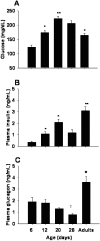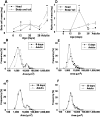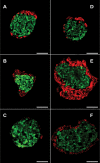Restructuring of pancreatic islets and insulin secretion in a postnatal critical window
- PMID: 17183663
- PMCID: PMC1762382
- DOI: 10.1371/journal.pone.0000035
Restructuring of pancreatic islets and insulin secretion in a postnatal critical window
Abstract
Function and structure of adult pancreatic islets are determined by early postnatal development, which in rats corresponds to the first month of life. We analyzed changes in blood glucose and hormones during this stage and their association with morphological and functional changes of alpha and beta cell populations during this period. At day 20 (d20), insulin and glucose plasma levels were two- and six-fold higher, respectively, as compared to d6. Interestingly, this period is characterized by physiological hyperglycemia and hyperinsulinemia, where peripheral insulin resistance and a high plasmatic concentration of glucagon are also observed. These functional changes were paralleled by reorganization of islet structure, cell mass and aggregate size of alpha and beta cells. Cultured beta cells from d20 secreted the same amount of insulin in 15.6 mM than in 5.6 mM glucose (basal conditions), and were characterized by a high basal insulin secretion. However, beta cells from d28 were already glucose sensitive. Understanding and establishing morphophysiological relationships in the developing endocrine pancreas may explain how events in early life are important in determining adult islet physiology and metabolism.
Conflict of interest statement
Figures






References
-
- Lucas A. Programming by early nutrition. An experimental approach. J Nutr. 1998;128:401S–406S. - PubMed
-
- Slack JMW. Developmental biology of the pancreas. Development. 1995;121:1569–1580. - PubMed
-
- Hughes SJ. The role of reduced glucose transporter content and glucose metabolism in the immature secretory responses of fetal rat pancreatic islets. Diabetologia. 1994;37:134–140. - PubMed
-
- Hole RL, Pian-Smith MC, Sharp GW. Development of the biphasic response to glucose in fetal and neonatal rat pancreas. Am J Physiol. 1988;254:E167–32. - PubMed
-
- Heinze E, Steinke J. Glucose metabolism of isolated pancreatic islets: difference between fetal, newborn and adult rats. Endocrinology. 1971;88:1259–1263. - PubMed
Publication types
MeSH terms
Substances
LinkOut - more resources
Full Text Sources
Medical

